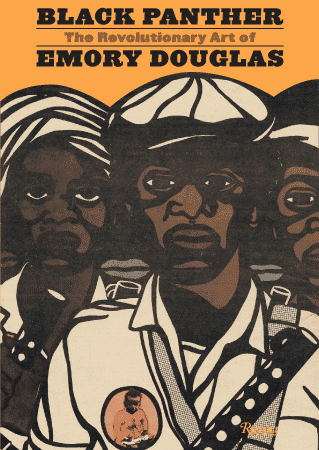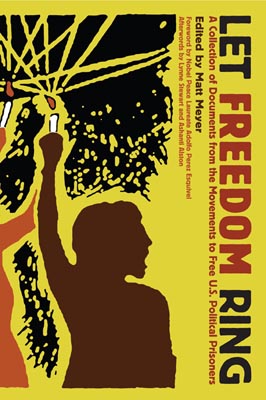Emory Douglas first served as the art director for the Black Panther Party’s newspaper, and later served as Minister of Culture until 1980. Throughout these years, Douglas’ iconic artwork was published in the BPP newspaper and beyond. His artwork is featured in the new book entitled Black Panther: The Revolutionary Art of Emory Douglas. For more information about Douglas, please click here.
Douglas was interviewed in San Francisco by Angola 3 News in October 2009. This is the first segment of our interview to be released. In this segment, Douglas speaks about the Angola 3, the prison-industrial complex, and abolishing solitary confinement.
Monday, October 26, 2009
Video Interview with Emory Douglas: The Angola 3, the Prison-Industrial Complex, and Abolishing Solitary Confinement
Tuesday, October 20, 2009
Torturing Women Prisoners -- an interview with Victoria Law
Victoria Law: The case of the
A3N: What other practices in US prisons would you consider to be torture?
VL: I consider the whole prison system to be torture. But to narrow it down to actual practices: I would consider the use of strip status, in which all of a person’s clothes and belongings are removed from the cell, as a form of torture. You have to remember that over half of incarcerated women have suffered past abuse and trauma. To strip them of all of their clothing and place them in a bare cell with guards watching them retraumatizes them. I recently reread an account from Lisa Savage, a woman who was placed on strip status for talking to the other women on her unit about the psychological reprogramming of the Close Management unit (a unit where women are held in their separate cells 23 ½ hours a day). Being on strip status meant that everything was taken from her—clothes, toothbrush, bedding, and sanitary napkins. She wrote, “As bad luck would have it, I just started my monthly. Now, I must beg for a pad for hours before receiving it.”
- The use of male guards in female prisons
- The shackling of pregnant women while they are in labor
- Loss of access and custody to their children simply because they are incarcerated
- The denial of health care and the life-threatening slow health care in prisons
VL: Yes! This is obvious in the case of the
A3N: How have women prisoners resisted the use of solitary confinement?
Sunday, October 18, 2009
Photos from Herman Wallace Birthday Event in New Orleans
Herman's writ seeking a new trial was denied late Friday afternoon by the Louisiana State Supreme Court with no comment from the Court. The denial was no surprise to the A3 legal team and supporters who have become accustomed to injustice at the hands of State and local officials. Although disappointed, Herman, Albert and Robert remind supporters that Herman's case can now begin new life as a habeas petition in Federal Court--the same judicial process that already succeeded in overturning Albert's conviction.
Herman Wallace
#76759
Elayn Hunt Correctional Center
Unit 5, D-Tier
PO Box 174
St Gabriel, LA 70776
Friday, October 16, 2009
The Assassination of George Jackson -- an interview with Colonel Nyati Bolt
 PHOTO: Colonel Nyati Bolt in his cell at Angola Prison in 1973. A "Free the San Quentin Six" poster is on the wall behind him.
PHOTO: Colonel Nyati Bolt in his cell at Angola Prison in 1973. A "Free the San Quentin Six" poster is on the wall behind him.Angola 3 News is excited to release the third interview in our new video-series focusing on the Angola 3 and the many issues that are central to their story, like racism, repression, prisons, human rights, solitary confinement as torture, and more.
This new interview features Colonel Nyati Bolt, who was an inmate at California’s San Quentin Prison at the same time as George Jackson (Sept. 23, 1941 - Aug. 21, 1971), the legendary Black Panther Party Field Marshal, and author of two books written behind bars: Soledad Brother and Blood In My Eye. The story of George Jackson and his legacy today will be the focus of many of our upcoming videos.
Bolt remembers the day of Jackson’s assassination in 1971, when Bolt was working in the medical unit. He explains that he was ordered to bring gurneys down before he’d heard any gunshots, leading him to believe that the guards’ shooting of Jackson was planned. When Bolt arrived outside and began to approach Jackson’s body to provide medical attention, he was shot at by guards, who forced him to retreat.
Please stay tuned for part two of our interview with Bolt, talking about his experience later at Louisiana State Penitentiary at Angola. As Bolt recently told National Public Radio, he walked from his cell to the cafeteria with Albert Woodfox, of the Angola 3, and was in the cafeteria with him on April 17, 1972, when a prison guard was killed at another part of the prison. Woodfox and co-defendant Herman Wallace would both be wrongly convicted of murdering the prison guard, and have now spent over 36 years in solitary confinement.
Bolt was immediately put into Closed Cell Restriction (CCR) solitary confinement on April 11, 1972, officially because he was under suspicion for involvement in the prison guard’s death. A few months later he was questioned by prison guards, where he told them that he’d been with Woodfox during the time period that the prison guard was killed. After questioning, Bolt was sent back to CCR, where he spent the next 20 years in continuous solitary confinement, until his release in 1992. Prison authorities officially justified continuing his CCR status on the original grounds that he was suspected of involvement in the prison guard’s death. Bolt believes that the continuous CCR was actually in retaliation for his statement to prison authorities that provided an alibi for Woodfox, which he would later testify to at Woodfox’s trial, and maintains to this day.
For more information about the Angola 3, please visit www.angola3news.com as well as our You Tube page for the latest in our new video series, including our two previous releases: an interview with author J. Patrick O’Connor about death-row prisoner Kevin Cooper and an interview with author Dan Berger about prison movements in the US. Angola 3 News is an official project of the International Coalition to Free the Angola 3.
Sunday, October 11, 2009
A3 Newsletter: Moving Up - Herman's Writ Denied

Herman's writ seeking a new trial was denied late Friday afternoon by the Louisiana State Supreme Court with no comment from the Court. The denial was no surprise to the A3 legal team and supporters who have become accustomed to injustice at the hands of State and local officials. Although disappointed, Herman, Albert and Robert remind supporters that Herman's case can now begin new life as a habeas petition in Federal Court--the same judicial process that already succeeded in overturning Albert's conviction.
Herman Moved to More Restrictive Cell!
This news is added to the fact that Herman has been placed in Extended Administrative Lockdown for the next 90 days for reasons yet unknown--overall this makes for a rotten way to spend a 68th birthday, even after 37+ in solitary. Send Herman some love and let him know we're here for the long haul.
In his new article written Friday evening, James Ridgeway provides an excellent analysis of Herman's case. Ridgeway writes:
The Louisiana State Supreme Court Friday denied an appeal from Herman Wallace, who has been held in solitary confinement for more than 37 years. Wallace and Albert Woodfox are members of what has become known as the
Read the full article here.
Read the Mother Jones series "

Herman Wallace
#76759
Elayn Hunt Correctional Center
Unit 5, D-Tier
PO Box 174
St Gabriel, LA 70776
Albert Woodfox
#72148
CCR, Lower A5
Louisiana State Penitentiary
Angola, LA 70712
Saturday, October 3, 2009
A3 Newsletter: Happy Birthday Herman!
Happy Birthday Herman!
On October 13th, Herman Wallace will be turning 68, having spent most of his life in solitary confinement. Please Write Herman and wish him Happy Birthday. Write to: Herman Wallace #76759 Elayn Hunt Correctional Center Unit 5, E-Tier PO Box 174 St Gabriel, LA 70776 USA
Herman is optimistic about his appeal now pending at the State Supreme Court, where a decision is expected anytime. On September 19, 2006, State Judicial Commissioner Rachel Morgan recommended overturning Herman's conviction, on grounds that prison officials had withheld evidence from the jury that prison officials had bribed the prosecution's key eyewitness, Hezekiah Brown, in return for his testimony. However, in May 2008, in a 2-1 vote, the State Appeals Court rejected Morgan's recommendation and refused to overturn the conviction. Herman has appealed this to the State Supreme Court, which will either affirm or reverse the lower court's decision.
If you haven't heard them yet, be sure to listen to Herman's many broadcasts at Prison Radio. Listen here.
Kudos To Parnell Herbert!
The new play "
Our Newest Video: Political Prisoners in the United States
Angola 3 News has just released a new interview with author/activist Dan Berger that is mostly based on Berger's essay "The Real Dragons: A Brief History of Political Militancy and Incarceration: 1960s to 2000s," which is featured in the book "Let Freedom Ring: A Collection of Documents from the Movements to Free U.S. Political Prisoners" (PM Press, 2008).
Watch the two-part video interview here. Also, be sure to watch our previous video focusing on death row prisoner Kevin Cooper here.
The Secret World of Deaf Prisoners
In his new article, published by The Crime Report, James Ridgeway writes:
The deaf face a nightmare when they fall into the criminal justice system. They live in a world apart to begin with; but in prison they are thrown into a dread new environment where they literally can't understand the language of either their jailers or the other prisoners. When people who have never heard a spoken word try to speak,the sounds come out jumbled and weird-leading ill-informed jailers to think they are obstreperous or crazy. As a consequence, some deaf prisoners can end up in solitary.
I discovered numerous examples of abuses and violations of the rights of deaf prisoners as part of an ongoing investigative reporting project. But the most troubling discovery I made was how little has been done about the problem in the criminal justice system-and how little is known about it outside prison walls.
Read the full article here.
Fax Jerry Brown Monday October 5! Drop the Charges Against Cisco Torres!
Support Cisco in court Friday, October 9
8am Rally, 9am Court, 850 Bryant Street, San Francisco
The Committee for the Defense of Human Rights writes:
Dear Friends,
Once again we are asking for your help with a phone and fax campaign to demand that CA Attorney General Jerry Brown drop the charges against Francisco Torres, the last of the SF8 still facing prosecution. Brown has not yet dropped the charges against Francisco Torres, but he knows there is no case against him. He needs to get the message from people all over the country that we will not give up this just demand.
Please Take Action Here.
Solitary Confinement is Torture!
The

Over the past three months, concerned
Now the Legislative Council will decide whether to accept the bill for the upcoming 2010 legislative session. THEY MAKE THEIR DECISION ON OCTOBER 15th. The Legislative Council comprises of leadership from both the Democratic and Republican parties from both the House and the Senate. Every other year in
Take Action Here.
Check out these new brochures made for the campaign, parts one and two. The Coalition can be contacted at mainepac@gmail.com and 207-252-5379
Journalist Lance Tapley has written an excellent series of articles detailing the numerous abuses in Maine Prisons. Read the full series.
Herman Wallace
#76759
Elayn Hunt Correctional Center
Unit 5, D-Tier
PO Box 174
St Gabriel, LA 70776
Albert Woodfox
#72148
CCR, Lower A5
Louisiana State Penitentiary
Angola, LA 70712









